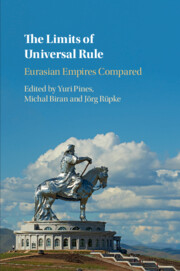Book contents
- The Limits of Universal Rule
- The Limits of Universal Rule
- Copyright page
- Contents
- Maps
- Figures
- Contributors
- Abbreviations
- Preface
- Introduction
- 1 From the Mediterranean to the Indus Valley: Modalities and Limitations of the Achaemenid Imperial Space
- 2 Limits of All-Under-Heaven: Ideology and Praxis of “Great Unity” in Early Chinese Empire
- 3 The Roman Empire
- 4 The Medieval Roman Empire of the East as a Spatial Phenomenon (300–1204 CE)
- 5 Early Islamic Imperial Space
- 6 The Mongol Imperial Space
- 7 The Territories and Boundaries of Empires
- 8 Delimiting the Realm Under the Ming Dynasty
- 9 The Expansion of the Qing Empire Before 1800
- 10 All Under the Tsar
- Index
- References
Introduction
Empires and Their Space*
Published online by Cambridge University Press: 07 January 2021
- The Limits of Universal Rule
- The Limits of Universal Rule
- Copyright page
- Contents
- Maps
- Figures
- Contributors
- Abbreviations
- Preface
- Introduction
- 1 From the Mediterranean to the Indus Valley: Modalities and Limitations of the Achaemenid Imperial Space
- 2 Limits of All-Under-Heaven: Ideology and Praxis of “Great Unity” in Early Chinese Empire
- 3 The Roman Empire
- 4 The Medieval Roman Empire of the East as a Spatial Phenomenon (300–1204 CE)
- 5 Early Islamic Imperial Space
- 6 The Mongol Imperial Space
- 7 The Territories and Boundaries of Empires
- 8 Delimiting the Realm Under the Ming Dynasty
- 9 The Expansion of the Qing Empire Before 1800
- 10 All Under the Tsar
- Index
- References
Summary
The Introduction to our volume starts by delineating changing attitudes towards the word “empire” in Western scholarship from the 20th to the 21st century. It then explains our concept of an empire as an entity with strongly pronounced aspirations to attain universal rule and with clear hegemonic position in its macro-region. We continue with a brief outline of the three waves of the empires’ formation in five Eurasian macro-regions (Near East, South Asia, Europe, East Asia, and the Inner Asian steppe belt). The second half of the Introduction deals with the factors that influenced spatial dimensions of Eurasian empires — from ideological and religious commitment to attaining universal rule to a variety of ecological, military, economic, and administrative considerations that prevented the empires’ leaders from realizing this goal. The multiplicity of these factors suffices to caution against any attempt to create a neat uniform scheme that would explain the empires’ expansion and contraction.
Keywords
- Type
- Chapter
- Information
- The Limits of Universal RuleEurasian Empires Compared, pp. 1 - 48Publisher: Cambridge University PressPrint publication year: 2021
References
- 1
- Cited by

